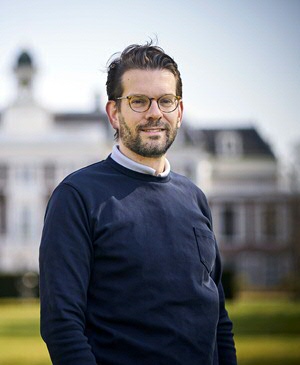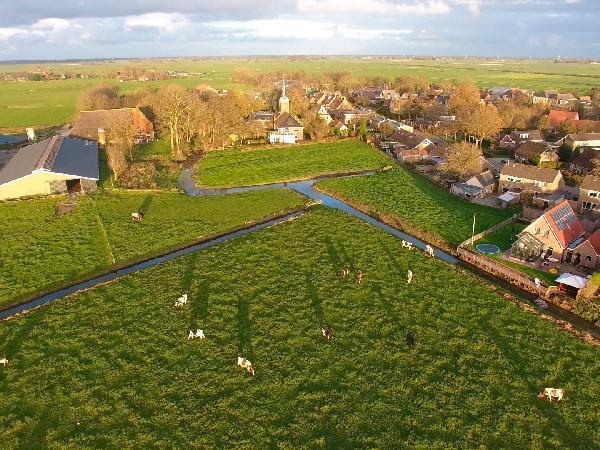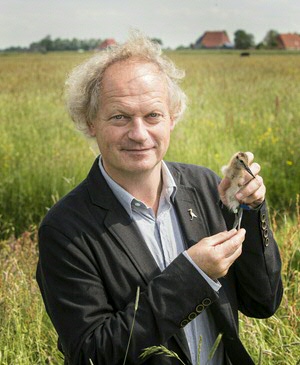Building strong foundations for a sustainable Northern Netherlands

Imagine being able to offer our three most northern provinces a prosperous, sustainable future. What would it take? Drawing inspiration from medieval cathedral builders, migratory bird expert Theunis Piersma and public administration specialist Caspar van den Berg put their heads together to ponder the question: What can we do in our lifetime that future generations will thank us for?
Our climate is changing. Our biodiversity is becoming impoverished. And in large parts of the Northern Netherlands, the population is ageing. University of Groningen professors Caspar van den Berg and Theunis Piersma contend that these problems cannot be addressed effectively without the development of a sustainable long-term vision – a vision that reaches beyond 2030 and that balances society’s economic and ecological interests.
Life in a healthy environment
What must be done to put the northern provinces of the Netherlands on the path to future-proof sustainability? Van den Berg explains that the long-term planning needs to take into account both the landscape and inhabitants. ‘Our point is that true prosperity is about more than just material wealth. Basically, we want to foster a happy, healthy living and working environment.’ An environment that fosters species diversity and maintains an open landscape, in which healthy food is produced without the use of artificial fertilizers and pesticides. And a region in which both citizens and farmers can earn a decent living.
Cathedrals
How do you go about formulating a solid long-term vision? The two professors have drawn inspiration from the recently published book The Good Ancestor by Roman Krznaric and believe in the need to think well beyond their own lifespans. ‘Building cathedrals in the Middle Ages took decades,’ Van den Berg explains. ‘The people who designed them seldom lived to see the end result. We can learn much from their future-oriented mindset. We need to ask ourselves, what can we do in our lifetime that future generations will thank us for? It’s pretty obvious that if we want to achieve systemic change, coming up with a four-year policy plan just isn’t going to cut it.’ Both professors emphasize the central importance of an integral approach. They are committed to finding the links between the various issues that arise, addressing them in their wider context and making policy and research decisions accordingly. ‘We work in quite different fields but what unites us is our common goal, namely the creation of a sustainable future.’

Lelylijn
Van den Berg names a pertinent example: the proposed Lelylijn railway connection, which would entail building a high-speed rail link between Groningen and Amsterdam. Unsurprisingly, the regional authorities are very much in favour of this project. ‘You might think: what’s not to love about it? This is exactly what we need to unlock the region, right? And I do understand the feeling that we have to strike while the political iron is hot. But ideally, the Lelylijn should be the outcome of a thorough debate about where we want the Northern Netherlands to be thirty years from now, in terms of both its economy and its ecology. Get that clear first, and then decide what kind of infrastructure you need. The Lelylijn shouldn’t be seen as an end in itself but as a tool that can be used to facilitate an integral vision for the future. If you don’t even have a vision, how can you tell whether this rail link would be beneficial?’ Precisely because of their lack of a clear vision, Van den Berg considers the regional authorities’ offer to build 100,000 extra homes in exchange for the Lelylijn understandable but ‘uninspiring’. ‘Their thinking is that as long as they get x billion euros from The Hague, everything will be fine. But what do they mean by ‘everything’? And how are they going to guard against negative side effects?’
Dead end
As Piersma sees it, the region is crying out for an integral approach. ‘You can’t expect to maintain the quality of life in the small villages without thinking about what kind of jobs the people living there are going to need. And the populations of farmland birds like black-tailed godwits and skylarks won’t grow unless we find new ways for dairy farmers to earn a decent living.’ Piersma is a migratory bird expert who has devoted almost 20 years to studying ruffs and black-tailed godwits. ‘Ruffs are almost extinct now. Black-tailed godwit numbers are plummeting simply because too few chicks are making it to adulthood. These developments have everything to do with the impact that intensive farming has had on our soil, water and biodiversity,’ he says. ‘Intensification is still happening, despite the best efforts of the many organizations and farmers who are trying to turn the tide. I have come to see industrial farming as a dead end. There are perfectly good alternatives, it’s just that we have yet to find an appropriate earning model that can be applied at a large enough scale.’
Daring to dream
Van den Berg and Piersma both believe in the importance of sharing ideas and dreams about what kind of world we want to live in. ‘People want their voices to be heard. It’s important for us to find out what’s going to make residents willing to buy into a healthy and sustainable future. That means asking people what really motivates them and where their priorities lie. We really need to have those conversations if we are to come up with a solution that will work.’

Glyphosate
Piersma sees the dwindling black-tailed godwit population as a societal problem, not a nature conservation issue. Van den Berg shares this view. ‘The black-tailed godwits are the messengers, the canaries in the coalmine. Their welfare gives us an indication of how the area as a whole is doing.’ They both agree that there’s no point in simply laying the responsibility at the feet of the farmers. ‘They are just part of a long chain that includes everything from banks and fertilizer plants to creameries and supermarkets. And at the end of the chain are the consumers. None of us can claim that agricultural transition and the meeting of nitrogen reduction targets have nothing to do with us.’ Piersma clearly feels strongly about the situation. ‘The government is protecting large companies while it stands by and watches villages go under in the face of intensive farming practices. Who’s going to want to live in rural areas while that’s happening? In fact, it can be downright dangerous. I recently saw a farmer spraying his land with glyphosate. It really bugs me to think that he was doing that purely because it’s a method that is earning him good money. And he’s not the only one. The fertilizer plant in Terneuzen, Bayer/Monsanto and the port of Rotterdam are all doing very nicely out of it too.’
Cooperatives
Blame is often laid at the feet of consumers who are unwilling to pay that bit extra for organic ‘godwit milk’. But Van den Berg finds that too simplistic. ‘Not everyone has the knowledge or – let’s face it – the money to be able to make those kinds of decisions.’ What citizens can do, though, is to form cooperatives. ‘For example, if five hundred households got together, they could set up a nature-inclusive farm and source their food from that. Their motivation might be something like this: we love the area. We enjoy living here and we don’t want to lose the landscape and the wide open spaces. We want people in generations to come to be able to enjoy what we have now and that’s why we source our food locally. The government could also support such initiatives by offering tax incentives.’
Caspar van den Berg (1980) is Professor of Global and Local Governance at the University of Groningen’s Campus Fryslân. In 2011, he received his doctorate from the University of Leiden and won the annual Van Poelje Award for the best PhD dissertation in the field of public administration in the Netherlands and Flanders. He spent 2013-2014 at Princeton University as visiting research fellow. Van den Berg is a member of the Council for Public Administration (Raad voor het Openbaar Bestuur, ROB) and Dean of the Metropolis Programme at the Dutch School for Public Administration. His most recent book is Policy Consultancy in Comparative Perspective, published in 2020.
Theunis Piersma (1958) is Professor of Global Flyway Ecology at the University of Groningen. He is also a senior researcher at the Royal Netherlands Institute for Sea Research (NIOZ) on the island of Texel. He studies the status of 15 migratory bird populations around the world (including black-tailed godwits and spoonbills in the Netherlands). He won the Dutch Research Council’s (NWO) Spinoza Prize in 2014 and, in 2020, he became the first non-Brit to be awarded the Godman-Salvin medal by the British Ornithologists’ Union. He has written more than 600 academic articles and around 20 books. Together with Thomas Oudman, he wrote The Escape of Nature: A new perspective on knowledge, published in 2018. April this year saw the publication of Sinagote, a book he wrote together with his partner and fellow biology graduate and researcher Petra de Goeij, tracing the life story of a spoonbill.
This article has been taken from our alumni magazine Broerstraat 5. Tekst Karin de Mik.
| Last modified: | 07 September 2021 1.10 p.m. |
More news
-
03 April 2025
IMChip and MimeCure in top 10 of the national Academic Startup Competition
Prof. Tamalika Banerjee’s startup IMChip and Prof. Erik Frijlink and Dr. Luke van der Koog’s startup MimeCure have made it into the top 10 of the national Academic Startup Competition.
-
01 April 2025
NSC’s electoral reform plan may have unwanted consequences
The new voting system, proposed by minister Uitermark, could jeopardize the fundamental principle of proportional representation, says Davide Grossi, Professor of Collective Decision Making and Computation at the University of Groningen
-
01 April 2025
'Diversity leads to better science'
In addition to her biological research on ageing, Hannah Dugdale also studies disparities relating to diversity in science. Thanks to the latter, she is one of the two 2024 laureates of the Athena Award, an NWO prize for successful and inspiring...
